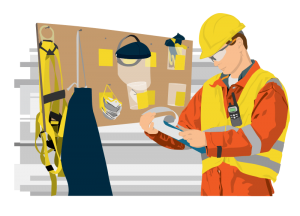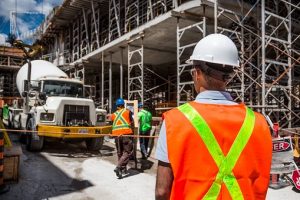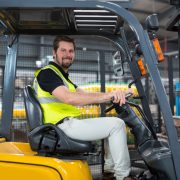When do I need a Safe Work Method Statement (SWMS)?
A Safe Work Method Statement (SWMS) is a document that identifies the high risk construction work activities that is to be carried out at a workplace, and the measures that will be put in place to control the risks. A SWMS must be prepared before any high risk construction work starts, and it is an administrative control to ensure all workers are aware of the dangerous risks involved.
Safe Work Australia has defined 18 categories for high risk construction work where a SWMS should be used:
| IDENTIFICATION OF HIGH RISK CONTRUCTION WORK | |||
| ☐ Risk of person falling more than 2 m
☐ Work on a telecommunications tower ☐ Demolition of a load-bearing structure ☐ Likely to involve disturbing of asbestos ☐ Temporary load-bearing support for structural alterations or repairs |
☐ Work in or near a confined space
☐ Work in or near a shaft or trench deeper than 1.5m or a tunnel ☐ Use of explosives ☐ Work on or near pressurised gas mains or piping ☐ Work on or near chemical, fuel or refrigerant lines |
☐ Work on or near energised electrical installations or services
☐ Work in an area that may have a contaminated or flammable atmosphere ☐ Work involving tilt-up or precast concrete ☐ Work on near a road/railway/shipping lane/other traffic corridor used by traffic other than pedestrians |
☐ Work in an area with movement of powered mobile plant
☐ Work in areas with artificial extremes of temperature ☐ Work in or near water or other liquid that involves a risk of drowning ☐ Diving work |
What information must be included in a SWMS?

A SWMS document must:
- Identify the work that is high risk construction work.
- Specify hazards relating to the high risk construction work and the risks to health and safety. Remember that a hazard is ‘something that causes harm’ (such as electricity, heights, moving plants etc) and a risk is ‘the chance of that hazard causing somebody harm’ (low, medium or high).
- Describe the measures to be implemented to control the risks, and
- Describe how the control measures are to be implemented, monitored and reviewed.
Many industry operators misunderstand what information should be included in a SWMS document. A common mistake is to include every step involved in the job, not just the high risk construction tasks, but other minor ones as well. This creates a lengthy SWMS document, with too much information that becomes cumbersome and even confusing for the supervisors and workers to use.
A SWMS is not intended to be a procedure – rather it is a tool to help supervisors and workers confirm and monitor the control measures required at the workplace.

When adding more information to the SWMS, consider whether it is relevant and useful, and whether it will add unnecessary length and complexity to the document. A SWMS document should be short and easily understood by all workers, including those from non-English speaking backgrounds. When possible, the use of pictures or diagrams should be used to better communicate information.
A SWMS should be focused on only describing the hazards involved with high risk construction work.
Other documents such as Safe Operating Procedures (SOPs) or Safe Work Instructions (SWIs) can be used to identify the lower risk hazards not addressed by the SWMS. These include manual handling, exposure to noise, dust inhalation etc. If required, SOPs and SWIs can be used to outline the step by step procedures required for the job, however these documents should be kept concise as an effective administrative safety control. A separate Operating Manual or the Manufacturer’s Handbook can be used to outline the lengthy step by step procedures of the job.
Can a generic SWMS be used?
The work environment, the workers involved, and the nature of the job involved will vary from one job to the next. It is important that a SWMS document reflect the specific circumstances of the workplace where the high risk construction work will be carried out. Thus a generic SWMS used at different workplaces may not address all the high risk construction work of the job and should be reviewed and amended as necessary.
One SWMS document can be used to cover a variety of tasks if it takes into account the changing nature of the work environment. Another method is to use a separate SWMS document for each high risk construction activity involved in the same job. However, care must be taken to ensure that overlapping high risk construction activities don’t impact each other (such as using powered mobile plant when working near water that involves a risk of drowning).
How do I Implement the SWMS?

WHS Regulations states that all construction work where the costs of the construction work is $250,000 or more, must have a ‘principal contractor’. This principal contractor must take all reasonable steps to obtain a SWMS document from all subcontractors carrying out high risk construction work before the work starts. The work should not proceed if the subcontractor does not have a SWMS document in place for their work. The principal contractor should then check that all SWMS documents submitted have met WHS regulations and all safety controls are satisfactory.
After the work has started, the principal contractor should continue to monitor that all high risk construction work is performed safely in accordance with the SWMS. Safe Work Australia states that the principal contractor’s WHS management plan is required to have specific arrangements for collecting, assessing, monitoring and reviewing the SWMS.
The SWMS document should be easily accessible and kept at the workplace where the high risk construction work is performed. If this is not possible, then the SWMS should be kept in a location where it can be delivered to the workplace quickly, either as written or electronic copies.
The above information is intended as a general guide only and may not suit your workplace. For more information on SWMS documents, please contact our qualified WHS consultants to discuss the specific needs of your workplace.











